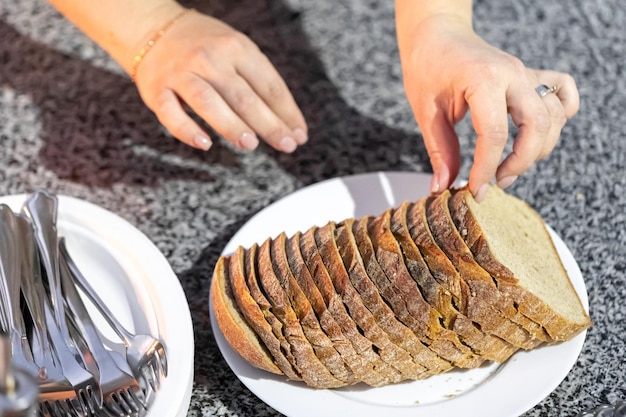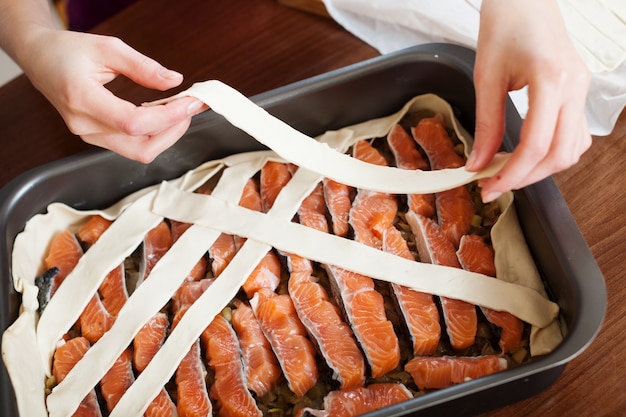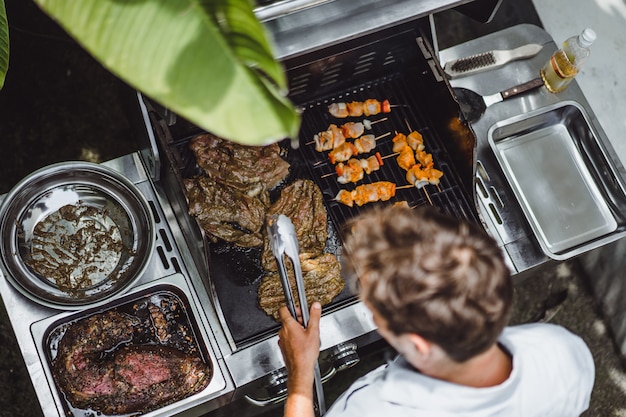(Part 1) The Right Cut for the Job: Choosing Your Brisket

Flat Cut: Lean and Mean
This is the leaner, more rectangular cut. It's ideal for slicing thin, yielding a lovely crust on the outside. Think of it as the brisket for the purist, the one who appreciates the distinct meaty flavour. However, it can be a bit more challenging to cook evenly, as it tends to dry out if you're not careful. A flat cut is often a great choice for a smaller gathering, as it produces less meat.Point Cut: Rich and Tender
This is the fattier, more rounded cut. It's renowned for its incredible tenderness, often described as "melt-in-your-mouth." The lovely marbling in the point cut keeps it juicy, making it a fantastic choice for larger gatherings. This is the brisket for the crowd-pleaser, the one who wants everyone to rave about the meal.Personally, I'm a point cut enthusiast! I can't resist that juicy, melt-in-your-mouth goodness. But don't worry, if you're feeling adventurous, a flat cut can be just as delicious with a little extra care.
(Part 2) Getting Ready for the Oven: Trimming and Seasoning

Trimming: Finding the Sweet Spot
Start by trimming away any excess fat. You want a nice layer of fat for flavour and moisture, but too much can hinder the cooking process. Aim for a good, even layer about a quarter inch thick. I like to use a sharp knife for this, but kitchen shears can also do the job. Just remember, be gentle and don't go overboard!Seasoning: A Symphony of Flavors
Now, this is where you can get creative! A simple salt and pepper rub is a classic, but don't be afraid to experiment. I like to add a touch of garlic powder, onion powder, paprika, and a hint of chili powder for a kick. Remember, the goal is to enhance the natural flavour of the brisket, not overwhelm it.Rubbing It In: Getting That Flavor Deep
Take your chosen seasoning and rub it all over the brisket. Make sure it gets into every nook and cranny! You want that flavour to penetrate deep into the meat. Some people prefer to let the brisket sit in the fridge overnight to allow the flavours to meld. If you're short on time, a couple of hours will do just fine.(Part 3) Oven-Baked Brisket: The Basics

Preheating: Setting the Stage for Success
Set your oven to a low temperature – 275°F (135°C) is a good starting point. It's all about low and slow with brisket, my friend. This gentle heat allows the meat to break down and become incredibly tender.Roasting: The Heart of the Process
Place your brisket in a roasting pan, fat side up. This helps the fat render and baste the meat during cooking. I like to add a cup or two of water to the bottom of the pan to create some steam. It helps keep the brisket moist and prevents it from drying out.Time for Patience: A Culinary Marathon
Now comes the waiting game. The cooking time depends on the size of your brisket, but expect it to be between 6-10 hours. Yes, you read that right – hours! It's a marathon, remember?(Part 4) Keeping an Eye on the Brisket: Temperature is Key
You've popped your brisket in the oven, and you're ready to relax. But don't get too comfy just yet! It's important to keep an eye on the temperature. You want to make sure the brisket is cooking evenly and at the right temperature. Here's how to do it:internal temperature: The Magic Number
The magic number for a perfectly cooked brisket is 203°F (95°C) internal temperature. Use a meat thermometer to check the temperature. Stick it into the thickest part of the brisket to get an accurate reading. Don't worry about overcooking the brisket, it won't get tough, just more tender!Check Every Couple of Hours: Maintaining Control
Every couple of hours, check the temperature and add a little more water to the pan if needed. You can also baste the brisket with the rendered fat, which will help keep it moist and flavorful.The Importance of Patience: Let the Brisket Do its Thing
It's tempting to peek at your brisket every few minutes, but try to resist! Opening the oven door too frequently can disrupt the temperature and slow down the cooking process. Just be patient, your brisket will be ready soon enough.(Part 5) The Telltale Signs of a Done Brisket: It's More than Just Temperature
Temperature is a good guide, but it's not the only indicator. A truly amazing brisket has a few other tricks up its sleeve:Tenderness: A Sign of Success
When the brisket is cooked through, it should be incredibly tender. You should be able to pull it apart easily with two forks. If it's still a bit tough, give it a bit more time in the oven.Moisture: Juicy and Delicious
The brisket should be juicy and moist, not dry and tough. You can test this by pressing on the brisket. If it springs back, it's not ready yet. If it gives a little and leaves an indentation, you're on the right track.Bark: The Crispy Crust
This is the crispy, caramelized crust that forms on the outside of the brisket during cooking. It should be a beautiful golden brown, with a nice crackle when you touch it. This is what gives the brisket its incredible flavor and texture.(Part 6) The Resting Ritual: Patience is a Virtue
You've reached the finish line, the brisket is cooked through, and you're ready to devour it. But hold your horses! Before you carve that beauty up, you need to let it rest. This step is crucial, so don't skip it!Why Resting Matters: Restoring the Juices
Resting allows the juices to redistribute throughout the brisket, making it even more tender and juicy. It also helps the bark solidify, preventing it from becoming soggy when you cut into the meat.How to Rest Your Brisket: The Right Approach
Simply wrap the brisket tightly in foil and let it rest for at least 2 hours. You can also place it in a cooler to keep it warm and prevent it from cooling down too quickly.(Part 7) Carving Time: Let’s Get to the Good Stuff
Alright, the moment of truth has arrived! The brisket has rested, the juices have redistributed, and you're ready to carve. Here are a few tips to make this step a breeze:Use a Sharp Knife: Clean and Even Slices
A sharp knife is essential for clean, even slices. If your knife is dull, it will shred the meat and make it difficult to carve.Against the Grain: Unlocking Tenderness
Cut the brisket across the grain. This will help tenderize the meat and make it easier to chew. If you cut with the grain, the meat will be tougher and more difficult to eat.Slice It Thin: Perfect for Sandwiches and More
Thin slices are perfect for sandwiches, tacos, or simply enjoying with a side of your favorite vegetables. If you prefer thicker slices, that's fine too! It's all about personal preference.(Part 8) The Delicious Aftermath: How to Serve and Store Your Brisket
You've done it! You've cooked a brisket to perfection. Now it's time to enjoy your hard work. Here are a few ideas on how to serve and store your masterpiece:Serving Suggestions: Unleashing the Flavor
There are so many ways to serve brisket! Here are a few of my favorites:- Sandwiches: Pile your sliced brisket high on crusty bread with your favorite toppings like pickles, onions, and bbq sauce.
- Tacos: Shred the brisket and fill soft tortillas with your choice of toppings like salsa, sour cream, and avocado.
- BBQ Platter: Serve the brisket alongside baked beans, coleslaw, and potato salad for a classic BBQ feast.
Storing Leftovers: Making the Most of Your Bounty
Leftover brisket is a true blessing! Store it in an airtight container in the refrigerator for up to 4 days. You can also freeze it for up to 3 months.(Part 9) Beyond the Basics: Some Tips and Tricks
Now that you have the basics down, here are a few extra tips and tricks to take your brisket game to the next level:The Power of a Wrap: Accelerating the Process
After the brisket has reached about 160°F (71°C) internal temperature, you can wrap it in foil and continue cooking. This helps to accelerate the cooking process and create a super tender brisket.Smoke it Up: Adding Authentic Flavor
If you're feeling adventurous, you can smoke your brisket for a truly authentic BBQ flavor. It takes a bit more time and effort, but the results are worth it!Experiment with Flavors: Beyond the Basics
Don't be afraid to experiment with different rubs and sauces. There are endless possibilities for flavor combinations. Try a sweet and spicy rub, or a tangy BBQ sauce.Don't Fear the Fat: Fat is Flavor
Remember, fat is flavor! Don't be afraid to use a good amount of fat in your rub and sauce. It will help keep the brisket moist and delicious.(Part 10) FAQs: Common Questions and Answers
You've learned a lot, but you may still have some burning questions. Here are answers to some common inquiries about cooking brisket in the oven:1. Can I cook brisket in a slow cooker?
Yes, you can! A slow cooker is a great option for cooking brisket. Just follow the same general guidelines as for oven cooking. Be sure to check the temperature and make sure the brisket is cooked through.2. How do I know if my brisket is done without a thermometer?
While a thermometer is the most accurate way to determine if your brisket is cooked through, you can also check for tenderness. If the brisket is easy to pull apart with two forks, it's likely done.3. What's the best way to reheat leftover brisket?
You can reheat brisket in the oven, slow cooker, or on the stovetop. I recommend wrapping the brisket in foil and reheating it in a low oven for about 30 minutes. This will help keep it moist and tender.4. Is it okay to overcook brisket?
Yes, you can overcook brisket, but it won't become tough. It will just become more tender and fall-apart.5. What if my brisket is dry?
If your brisket is dry, there are a few things you can do. You can add more moisture by wrapping it in foil with a little bit of broth or water. You can also make a sauce to add moisture and flavor.There you have it, a comprehensive guide to cooking brisket in the oven. Now go forth and conquer! Remember, patience and a little bit of experimentation are your best friends in this culinary journey. And most importantly, have fun! Happy brisket-ing!
Everyone is watching

Corn on the Cob: The Ultimate Guide to Perfectly Cooked Ears
Healthy MealsAh, corn on the cob. Just the name evokes images of sunny days, barbecues, and that sweet, juicy flavour that ...

Perfect Pork Roast Oven Cooking Time: A Guide to Delicious Results
Healthy MealsThere's something truly satisfying about a perfectly roasted pork. The aroma alone is enough to make your mout...

Ham Cooking Time: How Long to Bake, Smoke, or Boil a Delicious Ham
Healthy MealsAh, ham. It's a classic, isn't it? A real crowd-pleaser, especially around holidays. And when done right, it'...

Scallops: The Ultimate Guide to Perfect Cooking
Healthy MealsAh, scallops. Those delicate, sweet, and utterly delicious morsels of the sea. They hold a special place in my...

Spaghetti Squash: The Ultimate Guide to Cooking and Serving
Healthy MealsRemember that time you saw spaghetti squash at the supermarket, looking all bumpy and strange, and thought, "W...
